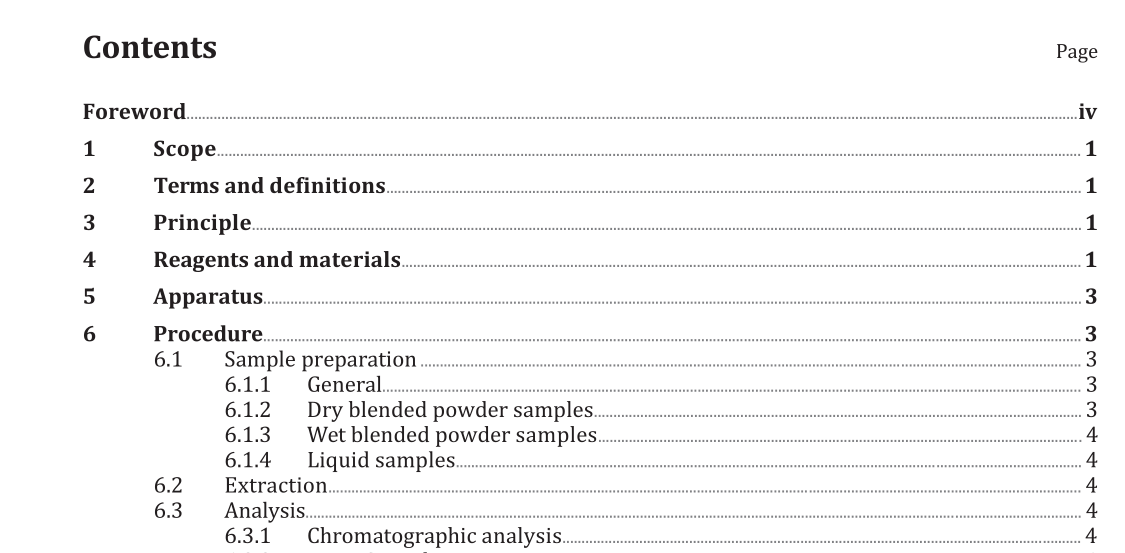BS ISO 20639:2015 pdf download.Infant formula and adult nutritionals — Determination of pantothenic acid by ultra high performance liquid chromatography and tandem mass spectrometry method (UHPLC-MS/MS)
1 Scope
This International Standard specifies a method for the quantitative determination of pantothenic acid, excluding bound forms, in infant formula and adult nutritionals (i.e. powders) using ultra high performance liquid chromatography and tandem mass spectrometry method (UHPLC-MS/MS).
2 Terms and definitions
For the purposes of this document, the following terms and definitions apply.
2.1 adult nutritional
nutritionally complete, specially formulated food, consumed in liquid form, which may constitute the sole source of nourishment, made from any combination of milk, soy, rice, whey, hydrolysed protein,starch and amino acids, with and without intact protein
2.2 infant formula
breast-milk substitute specially manufactured to satisfy, by itself, the nutritional requirements of infants during the first months of life up to the introduction of appropriate complementary feeding
[SOURCE: Codex Standard 72-1981]
3 Principle
Pantothenic acid is extracted using a 0,4 mol/l ammonium acetate buffer solution. After filtration, the final solution is subjected to ultra high performance liquid chromatography tandem mass spectrometry (UHPLC-MS/MS).
4 Reagents and materials
During the analysis, unless otherwise stated, use only reagents of recognized analytical grade and distilled or demineralized water or water of equivalent purity.
4.1 Standards
4.1.1 Calcium d-pantothenate, Sigma 1) or equivalent CAS 137-08-6.
4.1.2 Calcium pantothenate-[ 13 C 6 , 15 N 2 ], IsoSciences 1) or equivalent CAS 356786-94-2.
4.2 α-Amylase, Sigma A3176 1) , from porcine pancreas, about 25 U/mg or equivalent.
4.3 Solvents
4.3.1 Acetonitrile, LC grade or equivalent.
4.4 Ammonium acetate, ACS grade, > 98 % (Fluka 9690) 1) .
4.5 Acetic acid, ACS grade.
4.6 Formic acid, ACS grade.
4.7 1 % Formic acid in water, ACS grade.
4.8 Preparation of standard solutions
4.8.1 Pantothenic acid (PA) stock solution, ρ = 250 μg/ml. Weigh 54,5 mg of calcium pantothenate (4.1.1) into a 200 ml volumetric flask (take into account the moisture content given in the supplier’s certificate or dry to constant mass at 105 °C) and dilute to volume with water. Store aliquots at −20 °C.
4.8.2 Pantothenic acid intermediate solution, ρ = 10 μg/ml. Transfer 1 ml of PA stock solution (4.8.1) into a 25 ml volumetric flask and dilute to volume with water. Store aliquots at –20 °C.
4.8.3 Calcium pantothenate-[ 13 C 6 , 15 N 2 ] solution [IS (Internal Standard)] stock solution, ρ = 20 μg/ml. Weigh 5,0 mg of calcium pantothenate-[ 13 C 6 , 15 N 2 ] (4.1.2) into a 250 ml volumetric flask and dilute to volume with water. Store aliquots at –20 °C.
4.8.4 Solutions forthe five-levelstandardcurve. Transfer appropriate volumes of the PA intermediate solution (10 μg/ml) (4.8.2) into 10 ml volumetric flasks to obtain five different concentrations of PA (0,08 μg/ml, 0,16 μg/ml, 0,32 μg/ml, 0,64 μg/ml and 1,2 μg/ml). Add 500 μl of the IS stock solution (20 μg/ml) (4.8.3) and dilute to volume with water. The concentration of IS in each standard solution is 1 μg/ml. Store aliquots of these solutions at –20 °C for no longer than one month before use.
4.8.5 Ammonium acetate solution, c = 400 mmol/l, pH = 3,8 (used for sample extraction). Into a 500 ml beaker, add (30,8 ± 0,10) g ammonium acetate. Add about 300 ml water and stir to dissolve with a magnetic stirrer. Adjust to pH = 3,8 ± 0,1, carefully adding glacial acetic acid (about 150 ml is needed). Transfer into a 1 000 ml volumetric flask and make up to volume with water. This solution is stable for one month at 4 °C.
BS ISO 20639:2015 pdf download
